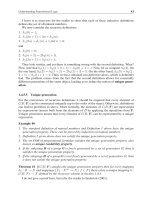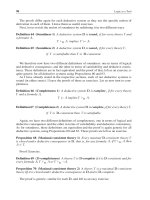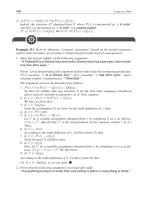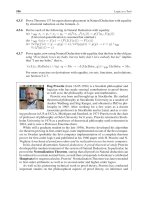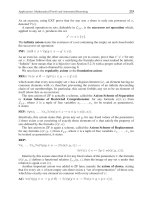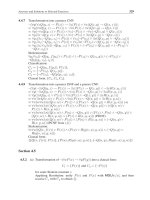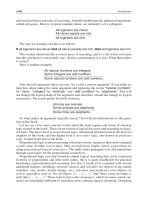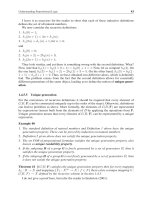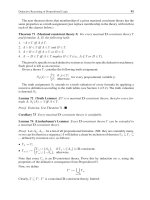Logic as a tool a guide to formal logical reasoning ( PDFDrive ) 309
Bạn đang xem bản rút gọn của tài liệu. Xem và tải ngay bản đầy đủ của tài liệu tại đây (65.62 KB, 1 trang )
285
Answers and Solutions to Selected Exercises
2.4.6 .(a) .
1
[¬r]
¬r ∨ p
2
3
[¬p] , [¬p → r]
r
⊥ 1
p
p → ¬q
¬q
¬q
(¬p → r) → ¬q
[p]2 p → ¬q
¬q
2
3
2.4.7 We formalize each of the propositional arguments by identifying the atomic propositions in them and replacing them with propositional variables. For a selection of
them, we then will prove the soundness of the resulting inference rule by deriving
it in ND.
(b) Denote
“Nina will go to a party” by p, and
“Nina will go to office” by q .
Then the argument becomes:
p ∨ ¬q, ¬p ∨ ¬q
.
¬q
The rule is derivable in ND and therefore sound, so the argument is correct.
¬q ∨ p
[¬q ]2
¬q
¬q ∨ ¬p
1
[¬q ]
¬q
¬q
[¬p]1 , [p]2
⊥
¬q
1
2
¬q
(d) Denote
“Socrates is happy” by p,
“Socrates is stupid” by q , and
“Socrates is a philosopher” by r .
Then the inference rule on which the argument is based is:
p ∨ ¬q, p → ¬r
.
r → ¬q
The rule is derivable in ND and therefore sound, so the argument is correct.
p ∨ ¬q
[p]1 , p → ¬r
r]2
¬r,
⊥
¬q
¬q
2
r → ¬q
[¬q ]1
¬q
1
